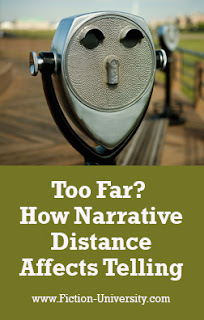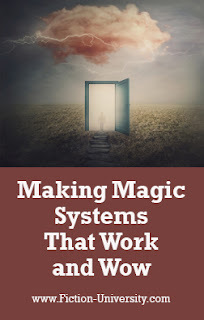Janice Hardy's Blog, page 16
October 11, 2021
How Far is Too Far? How Narrative Distance Affects Telling
 By Janice Hardy, @Janice_Hardy
By Janice Hardy, @Janice_Hardy There can be a fine line between a far narrative distance and telling.
Not all points of view use the same narrative distance. A first-person point of view pulls readers in close, while an omniscient point of view keeps them at a distance. Both are valid narrative distances, but the farther away you get from the reader, the riskier it is you’ll slip up and start telling instead of showing.
Maybe you pull away from the narrative for style, or because you want to show more than just what the point of view character knows. Maybe you aren’t comfortable inside a character’s head and don’t yet know what’s going on in there. Or maybe your point-of-view-skills are still a little shaky and you don’t even realize you’re doing it—until your get feedback with comments such as “this feels told” or “I felt detached from the character.”
I see this most often in third person point of view novels, where there’s already a layer of distance between reader and character. If you’re not solid in the point of view character’s head, it’s easy to forget who’s narrating the story and start explaining why characters act as they do, or what a character knows. If a distant omniscient narrator is your goal, that’s fine, but if you want a tighter perspective—that’s a problem.
Continue ReadingWritten by Janice Hardy. Fiction-University.com
October 9, 2021
WIP Diagnostic: Is This Working? A Closer Look at Writing a Non-Human POV
 Critique by Maria D'Marco
Critique by Maria D'Marco WIP Diagnostics is a weekly column that studies a snippet of a work in progress for specific issues. Readers are encouraged to send in work with questions, and we diagnose it on the site. It’s part critique, part example, and designed to help the submitter as well as anyone else having a similar problem.
If you're interested in submitting to WIP Diagnostics, please check out these guidelines.
Submissions currently in the queue: Seven
Please Note: As of today, critique slots are booked through November 27.
This week’s questions:
1. Does this opening work to hook the reader?
2. Does it establish the "alien" POV of the protagonist?
3. Does it establish the initial conflict and goal?
4. Does it need to be clear to the reader that this is a lab if the protagonist does not understand that concept?
Market/Genre: Science Fiction
On to the diagnosis…
Continue ReadingWritten by Janice Hardy. Fiction-University.com
October 7, 2021
Placing Short Fiction, Part Two: Contests and Red Flags
 By José Pablo Iriarte, @LabyrinthRat
By José Pablo Iriarte, @LabyrinthRatPart of the Focus on Short Fiction Series
JH: Contests can be a great way to get your writing out there, but be wary of those who take advantage of writers. José Pablo Iriarte shares some red flags that a publisher doesn't have your best interests in mind.
In my last guest post, I talked in general terms about selling short fiction, focusing on considerations such as how to find a market, how much pay rate might matter to you, how to format manuscripts, print versus online markets, and magazines versus anthologies. In my mind, the theme was You've finished you story . . . now what? As I said in July, though, there was really too much I wanted to say to be able to fit in one post, so now I'm back with more thoughts on what to do—or what not to do—with your short work. Today the focus is less on selling and more on adjacent questions, such as . . .
Continue ReadingWritten by Janice Hardy. Fiction-University.com
October 5, 2021
Making Magic Systems That Work and Wow
 By Bethany Henry
By Bethany HenryPart of The How They Do It Series
JH: There's something magical about making magic, and it's often a fantasy writer's favorite part of writing in that genre. Bethany Henry shares tips on how to create a compelling magic system for your novel.
Bethany Henry writes fantasy novels, and blogs about writing and wellness at bethany-henry.com. When not writing, she can often be found on the frisbee field, drinking tea, or reading picture books with her two little girls. Sign up for her email list for weekly posts on writing craft—along with fun extras like quotes and freebies.
Website | Blog | Facebook | Pinterest | Email List
Take it away Bethany...Continue ReadingWritten by Janice Hardy. Fiction-University.com
October 4, 2021
5 Ways to Restart Your Writing After a Break
 By Janice Hardy, @Janice_Hardy
By Janice Hardy, @Janice_Hardy Finding momentum after a writing break isn't easy, but there are tricks to ease yourself back into it.
Writing breaks happen for many reasons—from life getting in the way, to a lull in creativity, to being busy with other writing things that aren’t putting words to paper. For the lucky writers, returning to writing takes little to no time and the muse picks up where she left off.
For the rest of us… [repeated sound of forehead hitting the keyboard]
I haven't written a word in months due to a family medical issue, but unlike my previous breaks, getting back to work is harder this time. My focus is off, I'm easily distracted, and I run out of energy far to quickly. I suspect it'll be a while before I'm able to do any real quality writing.
In the past, this would have frustrated me to no end. This time, though, I know why it's so hard (just stress, and that's not changing any time soon), and I just have to take it a step at a time. Whatever I can do, I'll do, and when I need to stop, I will.Continue ReadingWritten by Janice Hardy. Fiction-University.com
October 2, 2021
WIP Diagnostic: Is This Working? A Closer Look at a Romantic Suspense First Page
 Critique by Maria D'Marco
Critique by Maria D'Marco WIP Diagnostics is a weekly column that studies a snippet of a work in progress for specific issues. Readers are encouraged to send in work with questions, and we diagnose it on the site. It’s part critique, part example, and designed to help the submitter as well as anyone else having a similar problem.
If you're interested in submitting to WIP Diagnostics, please check out these guidelines.
Submissions currently in the queue: Four
Please Note: As of today, critique slots are booked through October 30.
This week’s question:
1. Does this opening work?
Market/Genre: Romantic Suspense
On to the diagnosis…
Continue ReadingWritten by Janice Hardy. Fiction-University.com
September 3, 2021
I’m Taking a September Break
 By Janice Hardy, @Janice_Hardy
By Janice Hardy, @Janice_HardyEveryone, I have some news.
Things are a bit tough in the Hardy House right now, so I’m taking a month off from work. The blog will be quiet until October, and I won’t be doing my normal social media links or newsletters. Guest posts and critique diagnostics are on hold, and rescheduled for next month, but don’t worry, it’ll all be back soon. I still love you guys, and still love writing the blog. I just need some time to handle some “big life stuff.”
My husband was recently (and utterly out of the blue) diagnosed with cancer, and as you can imagine, writing is the last thing on my mind at the moment. This has all happened so fast and our heads are still spinning trying to process it. He started a month-long treatment yesterday, and I won’t have any extra focus or energy for all the things I usually do. Luckily, I can hit the pause button and take this break.
When life-changing events happen, it’s common to feel helpless and out of control, and want to do something, so I’m donating the proceeds of all September book sales to the Leukemia Research Foundation. Coincidentally, September is Blood Cancer Awareness Month, so I guess that’s good timing.
If you already have all my books, but still want to donate, here’s their website. And thanks for that.
Thank you for understanding, and for all the support and kind words everyone has always given me. I’ve been writing this blog for thirteen years now, and many of you have been here from the start. I appreciate that more than you know.
See you all in October,
JaniceWritten by Janice Hardy. Fiction-University.com
September 2, 2021
Struggling with Writing Burnout? Try These Tricks
 By Shanna Swendson, @ShannaSwendson
By Shanna Swendson, @ShannaSwendsonPart of The Writer’s Life Series
JH: After years of difficult times for everyone, many writers are struggling with burnout. Shanna Swendson shares ways to deal with not wanting to write and how to handle it.
Shanna Swendson earned a journalism degree from the University of Texas but decided it was more fun to make up the people she wrote about and became a novelist. She’s written a number of fantasy novels for teens and adults, including the Enchanted, Inc. series and the Rebel Mechanics series. She devotes her spare time to reading, knitting, and music. Her newest novel is the paranormal mystery Interview with a Dead Editor .
Website | Twitter | Facebook | Goodreads
Take it away Shanna…
Continue ReadingWritten by Janice Hardy. Fiction-University.com
September 1, 2021
On the Road: Is Your Story Hurting Your Novel?
 By Janice Hardy, @Janice_Hardy
By Janice Hardy, @Janice_HardyI'm over at Writers in the Storm today with 5 Ways Your Story Hurts Your Novel. Here's a sneak peek:
Written by Janice Hardy. Fiction-University.com
When your technical writing skills are at a professional level, but you're still not getting bites from agents, editors (or readers if you self-publish), it's time to look at the story itself.
One of the more frustrating aspects of being an author is the sheer unfairness of publishing. There’s a strange and unfathomable ratio between good writing and good storytelling that sends some manuscripts to the reject pile and others to the bestseller list.
And nobody knows what that ratio is—worse, it’s different for each person, and even each genre.
“Great writing” isn’t enough, and we’ve all read books that aren't well written but still sold millions of copies.
Now, I'm certainly NOT saying that good writing skill isn't something to worry about or work toward. Just that these “badly written best sellers” resonated with readers on such a deep level that they didn't care about the technical craft of the text. They didn't read them to marvel at the skills of the authors, they read them for the stories.
August 26, 2021
A Layered Method for Creating Consistent Characters
 By Ann Harth, @Annharth
By Ann Harth, @Annharth
Part of the How They Do It Series
JH: A great character has more to them that just a few obvious traits. Ann Harth shares a layered approached to creating compelling characters readers will love.
Developing believable characters is one of the most important components of writing fiction. One technique for creating three-dimensional, consistent characters is to know them as well as you know yourself – even before you start writing.
If you struggle with creating characters, it may help to think of developing a character layer by layer. Here is one simple, 8-layer method for developing a realistic character.
Layer 1. Create a still image.
Start by creating a sketchy character file that includes only physical attributes. Have a clear picture of your character in mind:
Hair color, length and texture Eye color, shape and size Skin tone - fair, dark, clear, spotty, splotchy Height and build Continue ReadingWritten by Janice Hardy. Fiction-University.com



